

Global Economics and Food Demand Ron Sands USDA Economic Research Service Kansas City, Missouri, USA The 25th Asia ‐ Pacific Integrated Modeling (AIM) International Workshop National Institute for Environmental Studies 18 ‐ 19 November 2019 Tsukuba, Japan The findings and conclusions in this presentation are those of the author and should not be construed to represent any official USDA or U.S. Government determination or policy. This research was supported in part by the U.S. Department of Agriculture, Economic Research Service.
Outline • Review of climate impact and adaption study by the Agricultural Model Intercomparison and Improvement Project (AgMIP) • Historical food consumption by major food group in large countries • Model projections of world food demand to 2050 – Per capita calories available for consumption – Crop calories needed to meet food demand – Variation across Shared Socio ‐ economic Pathways • Implications for land use 2
The climate modeling chain: From biophysical to socioeconomic Productivity 3
Economic Responses to a Decline in Agricultural Productivity Due to Climate Change in 2050 80% 60% 40% 20% 20% 11% 0% ‐ 2% ‐ 3% ‐ 11% ‐ 17% ‐ 20% ‐ 40% ‐ 60% Productivity Yield Area Production Consumption Price Change in Productivity is the exogenous shock. All other changes are endogenous responses relative to baseline. The black diamond is the average (mean) percent change with climate change compared to no climate change in year 2050; the height of a column is the range across climate models, crop models, and economic models. Results are a world average across major field crops: wheat, rice, coarse grains, and oil seeds. Source: Nelson et al. (2014) Proceedings of the National Academy of Sciences , Vol. 111(9): 3274 ‐ 3279. 4
Future demand for food World demand for food calories • – Food and Agriculture Organization (FAO) of the United Nations provides historical data to 2013 – Food available for consumption (includes waste at home and in restaurants) – Calories as unit of aggregation – Model ‐ based projections to 2050 – Shared Socioeconomic Pathways (SSPs) provide a range of scenarios, including variation in global diets, population, and per ‐ capita income – Global demand for food calories increases in all scenarios from 2010 to 2050 World demand for calories from crops • – Model ‐ based projections from 2010 to 2050 – Demand for crop calories increases by 52 percent from 2010 to 2050 in “middle of the road” scenario, or about 1.1 percent per year 5
1990 per ‐ capita calories available for consumption 4,000 3,500 3,000 2,500 kcal/cap/day animal products sugar and vegetable oils 2,000 fruits and vegetables grains and oil seeds 1,500 1,000 500 0 World USA Brazil China India Source: Food balances from the Food and Agriculture Organization (FAO) of the United Nations 6
2013 per ‐ capita calories available for consumption 4,000 3,500 3,000 2,500 kcal/cap/day animal products sugar and vegetable oils 2,000 fruits and vegetables grains and oil seeds 1,500 1,000 500 0 World USA Brazil China India Source: Food balances from the Food and Agriculture Organization (FAO) of the United Nations 7
Shared Socio ‐ economic Pathways: summary of key characteristics Attributes SSP1 SSP2 SSP3 Population U.N. low growth U.N. medium growth U.N. high growth Income High growth Medium growth Low growth Agricultural productivity High improvements Medium pace of Low technology in agricultural technological change development productivity; rapid diffusion of best practices Food consumption Low ‐ meat diets in transition Small increase in all food Greater increase in meat and developed countries products over time, except consumption in developing grains, in developing and and transition countries transition countries Note that the behavior of food consumption across scenarios is not consistent with income growth. The SSPs have animal product consumption growing fastest in the low ‐ income ‐ growth SSP3 scenario. This is opposite the pattern of observed behavior, where consumption of animal products grows with income. 8
World demand for food calories and crop calories 18,000 S3 crop calories 16,000 S2 crop calories 14,000 12,000 S3 food calories S1 crop calories S2 food calories 10,000 Scenarios of trillion calories from crops S1 food calories kcal 8,000 Scenarios of food calories 6,000 Historical food calories through 2013 4,000 2,000 0 1990 2000 2010 2020 2030 2040 2050 2060 Note: The dashed lines show the variation due only to changes in diets, from scenario “S2 low livestock” to scenario “S2 high livestock.” The change in food calories due to dietary preference, the difference between the dashed blue lines, is much smaller than the difference between the dashed green lines (crop calories). This magnifying effect is due to the quantity of feed calories required per calorie of animal product. 9
Land use change from 2010 to 2050 across selected scenarios S2 high S2 low S2 high S2 low S1 productivity livestock S2 livestock productivity S3 200 150 100 million hectares 50 0 ‐ 50 ‐ 100 ‐ 150 cropland grassland forest Note: Total world cropland in 2010 was approximately 1.5 billion hectares. 10
Summary • World demand for calories from crops – Model ‐ based projections from 2010 to 2050 – Demand for crop calories increases by 52 percent from 2010 to 2050 in “middle of the road” scenario, or about 1.1 percent per year • Drivers of food demand and land use – Shared Socio ‐ economic Pathways • Population • Income growth per capita • Dietary preference • Agricultural productivity – Climate change impacts and adaptation – Limiting CO 2 emissions through bioenergy 11
Recommend
More recommend